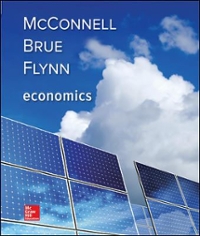Question
1.Cyclical unemployment happens because A. businesses make strategic errors. B. of government intervention C. inflation rates vary. D. of the ups and downs of the
1.Cyclical unemployment happens because
A. businesses make strategic errors.
B. of government intervention
C. inflation rates vary.
D. of the ups and downs of the business cycle.
2.Frictional unemployment occurs when
A. employees file grievances and are fired.
B. workers take time off to care for parents or children.
C. workers move from one job into another.
D. workers go back to school.
3.The unemployment rate includes
A. people not working because they are in school.
B. people who have given up looking for work.
C. people who are not working in order to stay at home with children.
D. people who are not employed but actively seeking work
4.A(n) _________ is defined as a significant decline in economic activity spread across the economy, lasting more than a few months.
A. recession
B. depression
C. economic deficit
D. regressive economy
5.The date a recession bottoms out is called the
A. peak.
B. expansion.
C. trough.
D. equilibrium.
6.Negative demand shifts can
A. be defined as an increase in demand without an increase in supply.
B. lead to a positive supply shift.
C. cause a recession.
D. be caused by falling aggregate production.
7.Problems in _____________ are another possible cause of recessions.
A. agricultural markets
B. financial markets
C. aggregate inputs
D. intermediate input markets
8.Which of the following is the formula for the potential growth rate?
A. The long-term labor force growth rate plus the long-term productivity growth rate
B. The short-term growth rate plus the long-term aggregate productivity growth rate
C. The short-term growth rate plus the long-term productivity growth rate
D. The short-term aggregate growth rate minus the long-term productivity growth rate
9.The Keynesian recommendation for a policy response to a recession consists of
A. increased government spending with tax cuts.
B. decreased government spending with tax cuts.
C. increased government spending with tax increases.
D. decreased government spending with tax increases.
10.The overall boost to economic activity that results from a government spending increase is called the
A.butterfly effect.
B. economic effect.
C. multiplier effect.
D. aggregate demand effect.
11.The portion that households spend of each additional dollar they receive is called the
A.after-tax incentive.
B. marginal propensity to consume.
C. marginal after-tax income.
D. natural tendency to consume
12.The transfer of domestic economic stimulus to foreign markets is known as
A.economic overage.
B. net export leakage.
C. overseas leakage.
D. fiscal offset.
13.In the short term, an increase in government spending may
A.reduce taxes and wages.
B. raise prices and wages.
C. raise taxes but reduce wages.
D. raise wages and reduce inflation.
14.During a recession, government spending to push up output and reduce unemployment is called
A.inflationary.
B. stimulative.
C. deflationary.
D. a fiscal devaluation
15.The single biggest federal tax is the
A.excise tax.
B. federal income tax.
C. estate tax.
D. corporate income tax
16.The tax you pay on your last dollar of income is called the
A.marginal propensity to pay tax.
B. average tax rate.
C. marginal rate of payment.
D. marginal tax rate.
17.The excess of the federal government'sexpenditures over its revenues is called the
A.surplus deficit.
B. budget deficit.
C. surplus effect.
D. budget surplus.
18.The Fed's control over interest rates, quantitative easing, and direct lending to financial institutions are some of the tools of
A.fiscal policy.
B. monetary policy.
C. discount policy.
D. margin control.
19.The Fed's margin requirements control
A. how much money people can borrow when they buy stock.
B. the amount of reserves banks must keep in cash or in their accounts with the Federal Reserve.
C. the federal funds rate.
D. the interest rate banks are allowed to pay on demand deposit accounts
20.The total of all past government borrowing, minus government budget surpluses, is called the
A.national cost.
B. public debt.
C. net debt load.
D. fiscal cost.
21.One of the advantages of monetary policy over fiscal policy is that
A.monetary policy must be approved by Congress, which prevents bad monetary policy from taking effect.
B. monetary policy does not produce inflation, whereas fiscal policy does.
C. the Fed can react more quickly than the legislature can.
D. monetary policy allows the Fed to limit government spending so that government budget deficits are reduced.
22.The current chairperson of the Federal Reserve Board is
A.Alan Greenspan.
B. Janet Yellen.
C. Ben Bernanke.
D. Jerome Powell
23.The Fed's response to the financial crisis of 2007 and 2008 was to
A. encourage discount window borrowing.
B. reduce taxes on financial institutions.
C. raise the federal funds rate.
D. raise the reserve requirement.
24.Which of the following would be the result of increasing the money available for banks to lend?
A.An increase in the reserve requirement
B. An increase in the discount rate
C. A decrease in the federal funds rate
D. A decrease in the Fed's holdings of U.S. Treasury securities
25.Which one of the following is among the Federal Reserve's tools to control short-term interest rates?
A. Open market operations
B. Raising or lowering taxes on financial institutions
C. Limits on credit card interest rates
D. Controlling the demand for money
Step by Step Solution
There are 3 Steps involved in it
Step: 1

Get Instant Access to Expert-Tailored Solutions
See step-by-step solutions with expert insights and AI powered tools for academic success
Step: 2

Step: 3

Ace Your Homework with AI
Get the answers you need in no time with our AI-driven, step-by-step assistance
Get Started


